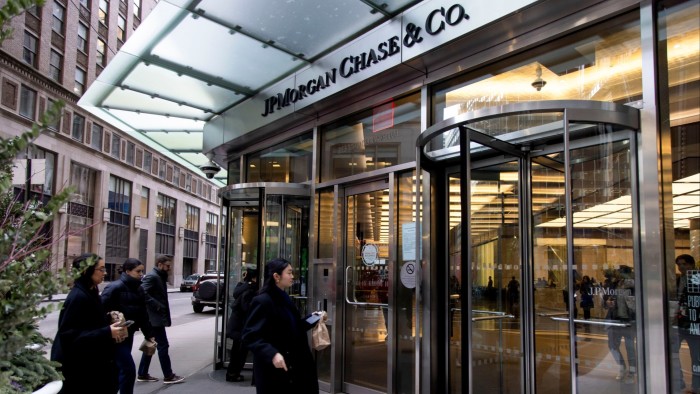Unlock the Editor’s Digest for free
Roula Khalaf, Editor of the FT, selects her favourite stories in this weekly newsletter.
JPMorgan Chase has dealt a blow to regulators’ efforts to understand the depth of ties between banks, buyout firms and the fast-growing private credit sector, declining to disclose its lending in an area of increasing systemic concern.
US banking regulators imposed a deadline of February 4 for lenders to disclose their year-end exposure to different types of “non-bank financial institutions” on a “best-efforts basis”. Banks have until after the end of the second quarter to be fully compliant.
Bank of America, Citigroup, Goldman Sachs, Morgan Stanley and Wells Fargo supplied breakdowns of their lending, providing a window into the extent of mainstream banks’ linkages with a growing but still opaque part of the financial system.
But the US’s largest bank labelled all $133bn of its lending to non-banks as “other” in its quarterly report filed with the Federal Deposit Insurance Corporation rather than breaking it down by type of borrower. That sum is more than the total loans of all but a handful of the nation’s largest banks.
A person familiar with JPMorgan’s decision said the bank believed there was an “operational risk” in reporting its loan categories one way to the FDIC and another to the Federal Reserve, which has stuck with previous reporting requirements and guidelines for disclosing loans to non-banks. The FDIC declined to comment.
Regulators have sought more information about banks’ exposure to non-bank financial institutions as the sector has grown and the potential for wider systemic risks has increased.
Loans to non-bank lenders totalled nearly $1.2tn at the end of 2024, putting them on par with mortgage loans to commercial real estate developers and consumer credit card loans, according to an analysis of the FDIC data by aggregator BankRegData.
“Non-banks have become some of the most important and potentially risky borrowers of the large US banks,” said Viral Acharya of New York university’s Stern School of Business. “Right now the only one who has a picture of how much of risky this is, it’s the Fed, and only of the banks that it stress tests.”
Loans by banks to “non-depository financial firms” have soared from just over $50bn in 2010, according to data from the US Fed. The central bank this month said that it would introduce an analysis of non-bank financial institutions and the risks they could pose to the nation’s largest banks as part of this year’s stress tests.
Direct lenders and private credit funds often lend to companies that are themselves more leveraged and can have trouble borrowing from traditional banks. Borrowing some of the money to make these loans can increase the returns of their investors, but it also increases the risk to the financial system.
Even excluding JPMorgan from the FDIC data, the new disclosures show how private credit and private equity funds have become big borrowers from traditional banks. US banks reported $214bn in outstanding loans to credit funds and other direct business lenders and another $200bn to private equity funds, the data show.
Lending to companies within the private equity orbit will be higher still as the figures do not include lending to portfolio companies.
Wells Fargo alone reported $91bn in loans to private credit firms and private equity funds at the end of 2024 in its filings to the FDIC. That was more than any other bank, and more than 10 per cent of its $887bn in overall loans at the end of last year.
“We continue to think this is a limited risk for the banks in terms of financial stability,” said Julie Solar, an analyst at Fitch Ratings. “But as private credit continues to grow and evolve, you have the question of how banks manage that risk.”
Read the full article here




